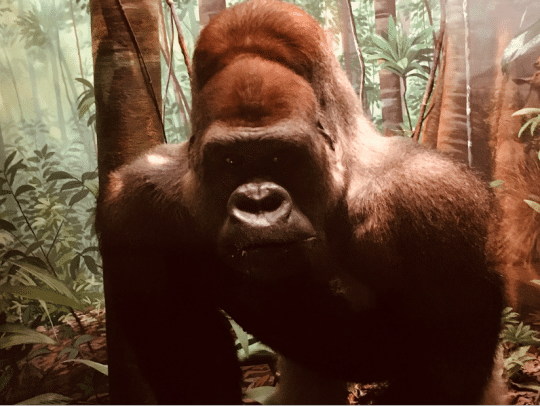
The lowland gorilla within the Hall of African Wildlife has a far different back-story than other large mammals in the exhibition’s dozen dioramas. All of the hall’s mammal taxidermy mounts are the preserved remains of creatures that once lived in the wilds of the African Continent. Most were collected between 1909 and 1912, during the course of two hunting safaris led by Childs Frick, son of Pittsburgh industrialist Henry Clay Frick. The gorilla was a far later addition to the stuffed menagerie, and its arrival occurred under entirely different circumstances.
The animal that grew to be a magnificent 350-pound silverback, was captured at a young age in Gabon, West Africa, sometime in the early 1960s. The gorilla lived in zoos afterward, initially in Copenhagen, Denmark, and later in Pittsburgh, where it died unexpectedly of natural causes in 1979.
Zoo staff offered the gorilla remains to museum curators, and through the efforts of a skilled team of taxidermists, an animal long known to zoo visitors as “George” came back into public view in an alert, but frozen stance.
Today it’s not unusual to occasionally hear museum visitors recalling the gorilla’s crowd-pleasing antics as a zoo attraction. The taxidermy mount’s far more important role, however, is as an educational tool capable of holding eye contact, and thereby encouraging contemplation. In staring contests that the glass-eyed mount never loses, the gorilla represents all of its wild living kind, the entire population of our planet’s largest primates, close relatives of modern humans, and a group whose continued existence is increasingly threatened by illegal hunting, habitat loss, and disease.
Scientists who study these great apes recognize two species of gorillas, each of which contain two sub-species, and all of which are considered critically endangered. The museum specimen, owing to its origin in Gabon, bears the echoing scientific name Gorilla gorilla gorilla to note its genus, species, and subspecies designation.
For anyone at a loss about what to contemplate while holding the gaze of this hall’s famous resident, consider some of what Terry Tempest Williams has to say in her 2019 work, Erosion: Essays of Undoing. The author begins an essay about a guided visit to observe mountain gorillas (Gorilla beringei beringei) in the Virunga Mountains of Rwanda with an appeal to senses that don’t come into play in museum exhibit halls. “We smelled them before we heard them. We heard them before we saw them.”
Later, amidst information about how members of the observed gorilla clan were refugees from an adjacent national park in war-torn Congo, and how their continued sanctuary in Rwanda is tenuous due to that nation’s rapidly growing population, relatively small size, and the discovery of oil deposits in the Virunga Mountains, Williams offers this thought:
“I wish there was a gorilla in every corner of our imagination to remind us what we are choosing to harm and ignore. I wish we could smell them, hear them, see them for who they are in place, and know them by name: the most gentle of creatures, with strength and power.”
For more information about gorillas, please visit this Wildlife Conservation Society site.
Patrick McShea works in the Education and Visitor Experience department of Carnegie Museum of Natural History. Museum employees are encouraged to blog about their unique experiences and knowledge gained from working at the museum.
Related Content
Ask a Scientist: Can you tell us the story of Harvey, the big rabbit?
